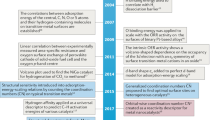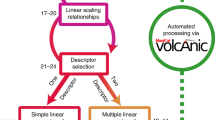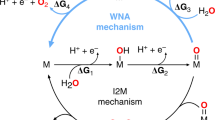Abstract
The search for new catalytic materials has relied on highly time- and human- resource-consuming procedures. The appearance of theoretical methods that employ density functional theory coupled to kinetic models has allowed the rational understanding of activity volcano plots and selectivity abrupt profiles that resemble cliffs. However, these methodologies present several drawbacks as the optimization is confined to a family of materials, typically metals, and not applied to the overall phase and compositional space, therefore the maximum activity might not be sufficient for practical applications. Volcanos emerge from the symmetry between the adsorption energies of different intermediates on the catalyst, and thus circumventing these dependencies is crucial to identify better catalytic materials. Here we present a revision of the advances in the field that indicate that complexity in the materials is key to identifying alternative paths and thus overcome the drawbacks of scaling relationships.
This is a preview of subscription content, access via your institution
Access options
Access Nature and 54 other Nature Portfolio journals
Get Nature+, our best-value online-access subscription
$29.99 / 30 days
cancel any time
Subscribe to this journal
Receive 12 digital issues and online access to articles
$119.00 per year
only $9.92 per issue
Buy this article
- Purchase on Springer Link
- Instant access to full article PDF
Prices may be subject to local taxes which are calculated during checkout


Similar content being viewed by others
References
P. Sabatier. La Catalyse en Chimie Organique (Librarie Polytechnique, Paris, 1913).
Balandin, A. Modern State of the Multiplet Theory of Heterogeneous Catalysis 1. Adv. Catal. Rel. Subj. 19, 1 (1969).
Nørskov, J. K., Bligaard, T., Rossmeisl, J. & Christensen, C. H. Towards the computational design of solid catalysts. Nat. Chem. 1, 37–46 (2009).
Nørskov, J. K., Studt, F., Abild-Pedersen, F., Bligaard, T. Fundamental concepts in heterogeneous catalysis (Wiley, 2014).
Lejaeghere, K. et al. Reproducibility in density functional theory calculations of solids. Science 351, aad3000 (2016).
Medford, A. J. et al. From the Sabatier principle to a predictive theory of transition-metal heterogeneous catalysis. J. Catal. 328, 36–42 (2015).
Ardagh, M. A., Abdelrahman, O. A. & Dauenhauer, P. J. Principles of dynamic heterogeneous catalysis: surface resonance and turnover frequency response. ACS Catal. 9, 6929–6937 (2019).
Greeley, J. et al. Alloys of platinum and early transition metals as oxygen reduction electrocatalysts. Nat. Chem 1, 552–556 (2009).
Vilè, G. et al. Silver nanoparticles for olefin production: new insights into the mechanistic description of propyne hydrogenation. ChemCatChem 5, 3750–3759 (2013).
Choksi, T., Majumdar, P. & Greeley, J. P. Electrostatic origins of linear scaling relationships at bifunctional metal/oxide interfaces: a case study of Au nanoparticles on doped MgO substrates. Angew. Chem. Int. Ed. 57, 15410–15414 (2018).
Koper, M. T. M. Volcano activity relationships for proton-coupled electron transfer reactions in electrocatalysis. Top. Catal. 58, 18–20 (2015).
Busch, M., Wodrich, M. D. & Corminboeuf, C. Linear scaling relationships and volcano plots in homogeneous catalysis–revisiting the Suzuki reaction. Chem. Sci. 6, 6754–6761 (2015).
Busch, M. et al. Beyond the top of the volcano?–A unified approach to electrocatalytic oxygen reduction and oxygen evolution. Nano Energy 29, 126–135 (2016).
Halck, N. B., Petrykin, V., Krtil, P. & Rossmeisl, J. Beyond the volcano limitations in electrocatalysis–oxygen evolution reaction. Phys. Chem. Chem. Phys. 16, 13682–13688 (2014).
Li, Y. & Sun, Q. Recent advances in breaking scaling relations for effective electrochemical conversion of CO2. Adv. Ener. Mat. 6, 1600463 (2016).
Szécsényi, Á. et al. Breaking linear scaling relationships with secondary interactions in confined space: a case study of methane oxidation by Fe/ZSM-5 zeolite. ACS Catal. 9, 9276–9284 (2019).
Cao, A. et al. Mechanistic insights into the synthesis of higher alcohols from syngas on CuCo alloys. ACS Catal. 8, 10148–10155 (2018).
Kanady, J. S. et al. Synthesis of Pt3Y and other early–late intermetallic nanoparticles by way of a molten reducing agent. J. Am. Chem. Soc. 139, 5672–5675 (2017).
García-Muelas, R. Minimalistic microkinetic model with volcanoes and cliffs. Zenodo https://doi.org/10.5281/zenodo.3338280 (2019).
Abild-Pedersen, F. et al. Scaling properties of adsorption energies for hydrogen-containing molecules on transition-metal surfaces. Phys. Rev. Lett. 99, 016105 (2007).
Calle-Vallejo, F. et al. Introducing structural sensitivity into adsorption-energy scaling relations by means of coordination numbers. Nat. Chem. 7, 403–410 (2015).
Bligaard, T. et al. The Bronsted–Evans–Polanyi relation and the volcano curve in heterogeneous catalysis. J. Catal. 224, 206–217 (2004).
Medford, A. J. et al. Activity and selectivity trends in synthesis gas conversion to higher alcohols. Top. Catal. 57, 135–142 (2014).
Vojvodic, A. & Nørskov, J. K. New design paradigm for heterogeneous catalysts. Natl. Sci. Rev. 2, 140–149 (2015).
Wang, H. et al. Disentangling the size-dependent geometric and electronic effects of palladium nanocatalysts beyond selectivity. Sci. Adv. 5, eaat6413 (2019).
Khorshidi, A., Violet, J., Hashemi, J. & Peterson, A. A. How strain can break the scaling relations of catalysis. Nat. Catal. 1, 263–268 (2018).
Kyriakou, G. et al. Isolated metal atom geometries as a strategy for selective heterogeneous hydrogenations. Science 335, 1209–1212 (2015).
Lindlar, H. Ein neuer Katalysator für selektive Hydrierungen. Helv. Chim. Acta 35, 446 (1952).
Vilè, G. et al. From the Lindlar catalyst to supported ligand modified palladium nanoparticles: selectivity patterns and accessibility constraints in the continuous flow three phase hydrogenation of acetylenic compounds. Chem. Eur. J. 20, 5926–5937 (2014).
Vilè, G. et al. A stable single site palladium catalyst for hydrogenations. Angew. Chem. Int. Ed. 54, 11265–11269 (2015).
Darby, M. T., Stamatakis, M., Michaelides, A. & Sykes, E. C. H. Lonely atoms with special gifts: breaking linear scaling relationships in heterogeneous catalysis with single-atom alloys. J. Phys. Chem. Lett. 9, 5636–5646 (2018).
McKenna, F.-M. & Anderson, J. A. Selectivity enhancement in acetylene hydrogenation over diphenyl sulphide-modified Pd/TiO2 catalysts. J. Catal. 281, 231–240 (2011).
Albani, D. Selective ensembles in supported palladium sulfide nanoparticles for alkyne semi-hydrogenation. Nat. Comm. 9, 2634 (2018).
Vajda, S. et al. Subnanometre platinum clusters as highly active and selective catalysts for the oxidative dehydrogenation of propane. Nat. Mat. 8, 213–216 (2009).
Voroyeva, E. et al. Atom-by-atom resolution of structure–function relations over low‐nuclearity metal catalysts. Angew. Chem. Int. Ed. 58, 8724 (2019).
Frei, M. S. et al. Atomic-scale engineering of indium oxide promotion by palladium for methanol production via CO2 hydrogenation. Nat. Comm. 10, 3377 (2019).
Marcinkowski, M. D. et al. Pt/Cu single-atom alloys as coke-resistant catalysts for efficient C–H activation. Nat. Chem. 10, 325–332 (2018).
Sun, D. et al. Breaking the scaling relationship via thermally stable Pt/Cu single atom alloys for catalytic dehydrogenation. Nat. Comm. 9, 4454 (2018).
Batchelor, T. A. A. et al. High-entropy alloys as a discovery platform for electrocatalysis. Joule 3, 834–845 (2019).
Studt, F. Volcano relation for the Deacon process over transition metal oxides. ChemCatChem 2, 98–102 (2010).
Moser, M. et al. The virtue of defects: stable bromine production by catalytic oxidation of hydrogen bromide on titanium oxide. Angew. Chem. Int. Ed. 53, 8628–8633 (2014).
Lari, G. M. et al. Hybrid palladium nanoparticles for direct hydrogen peroxide synthesis: the key role of the ligand. Angew. Chem. Int. Ed. 129, 1801–1805 (2014).
Ortuño, M. A. Selective electrochemical nitrogen reduction driven by hydrogen bond interactions at metal–ionic liquid interfaces. J. Phys. Chem. Lett. 10, 513–517 (2019).
Horiuti, I. & Polanyi, M. Exchange reactions of hydrogen on metallic catalysts. J. Chem. Soc. Faraday Trans. 30, 1164–1172 (1934).
Fiorio, J. L., López, N. & Rossi, L. M. Gold–ligand-catalyzed selective hydrogenation of alkynes into cis-alkenes via H2 heterolytic activation by frustrated lewis pairs. ACS Catal. 7, 2973–2980 (2017).
Almora-Barrios, N., Cano, I., van Leeuwen, P. W. N. M. & López, N. Concerted chemoselective hydrogenation of acrolein on secondary phosphine oxide decorated gold nanoparticles. ACS Catal. 7, 3949–3954 (2017).
García-Melchor, M. & López, N. Homolytic products from heterolytic paths in H2 dissociation on metal oxides: the example of CeO2. J. Phys. Chem. C. 118, 10921–10926 (2014).
Albani, D. et al. Interfacial acidity in ligand-modified ruthenium nanoparticles boosts the hydrogenation of levulinic acid to gamma-valerolactone. Green. Chem. 19, 2361–2370 (2017).
Wang, Y.-H. et al. Brønsted acid scaling relationships enable control over product selectivity from O2 reduction with a mononuclear cobalt porphyrin catalyst. ACS Cent. Sci. 5, 1024–1034 (2019).
Almora-Barrios, N. et al. Electrochemical effects at surfactant–platinum nanoparticle interfaces boost catalytic performance. ChemCatChem 9, 604–609 (2017).
Zhang, W. et al. Enhanced electrochemical water splitting with chiral molecule-coated Fe3O4 nanoparticles. ACS Energy Lett. 3, 2308–2313 (2018).
Tuokko, S., Pihko, P. M. & Honkala, K. First principles calculations for hydrogenation of acrolein on Pd and Pt: chemoselectivity depends on steric effects on the surface. Angew. Chem. Int. Ed. 128, 1702–1706 (2016).
García-Muelas, R. et al. Origin of the selective electroreduction of carbon dioxide to formate by chalcogen modified copper. J. Phys. Chem. Lett. 9, 7153–7159 (2018).
Zhan, S., De Gracia Triviño, J. A. & Ahlquist, M. S. G. The carboxylate ligand as an oxide relay in catalytic water oxidation. J. Am. Chem. Soc. 141, 10247–10252 (2019).
Zhang, B. et al. Homogeneously dispersed multimetal oxygen-evolving catalysts. Science 352, 333–337 (2016).
Zandkarimi, B. & Alexandrova, A. N. Dynamics of subnanometer Pt clusters can break the scaling relationships in catalysis. J. Phys. Chem. Lett. 10, 460–467 (2019).
Ortuño, M. A. & Lopez, N. Creating cavities at palladium–phosphine interfaces for enhanced selectivity in heterogeneous biomass conversion. ACS Catal. 8, 6138–6145 (2018).
Kauppinen, M. M., Korpelin, V., Verma, A. H., Melander, M. M., Honkala, K. Escaping scaling relationships for water dissociation at interfacial sites of zirconia-supported Rh and Pt clusters. Preprint at https://doi.org/10.26434/chemrxiv.9761477.v1 (2019).
Gani, T. Z. H. & Kulik, H. J. Understanding and breaking scaling relations in single-site catalysis: methane to methanol conversion by FeIV═O. ACS Catal. 8, 975–986 (2018).
Daelman, N., Capdevila-Cortada, M., López, N. Dynamic charge and oxidation state of Pt/CeO2 single-atom catalysts. Nat. Mat. https://doi.org/10.1038/s41563-019-0444-y (2019).
Robertson, J. C., Coote, M. L. & Bissember, A. C. Synthetic applications of light, electricity, mechanical force and flow. Nat. Rev. Chem. 3, 290–304 (2019).
James, S. L. et al. Mechanochemistry: opportunities for new and cleaner synthesis. Chem. Soc. Rev. 41, 413–447 (2012).
Linic, S., Christopher, P. & Ingram, D. B. Plasmonic-metal nanostructures for efficient conversion of solar to chemical energy. Nat. Mat. 10, 911–321 (2011).
Garcés-Pineda, F. et al. Direct magnetic enhancement of electrocatalytic water oxidation in alkaline media. Nat. Energy 4, 519–525 (2019).
Acknowledgements
We would like to thank E. Fako and R. García-Muelas for their assistance with Figs., microkinetic modelling and for critically reading the manuscript.
Author information
Authors and Affiliations
Corresponding authors
Ethics declarations
Competing Interests
The authors declare no competing interests.
Additional information
Publisher’s note Springer Nature remains neutral with regard to jurisdictional claims in published maps and institutional affiliations.
Rights and permissions
About this article
Cite this article
Pérez-Ramírez, J., López, N. Strategies to break linear scaling relationships. Nat Catal 2, 971–976 (2019). https://doi.org/10.1038/s41929-019-0376-6
Received:
Accepted:
Published:
Issue Date:
DOI: https://doi.org/10.1038/s41929-019-0376-6
This article is cited by
-
Nanocurvature-induced field effects enable control over the activity of single-atom electrocatalysts
Nature Communications (2024)
-
Emerging Atomically Precise Metal Nanoclusters and Ultrasmall Nanoparticles for Efficient Electrochemical Energy Catalysis: Synthesis Strategies and Surface/Interface Engineering
Electrochemical Energy Reviews (2024)
-
Tailoring the d-band center on Ru1Cu single-atom alloy nanotubes for boosting electrochemical non-enzymatic glucose sensing
Analytical and Bioanalytical Chemistry (2024)
-
Activity and stability of catalysts for electrocatalytic water splitting in acidic media
Science China Materials (2024)
-
Bridging the complexity gap in computational heterogeneous catalysis with machine learning
Nature Catalysis (2023)



